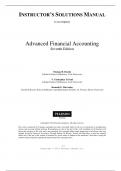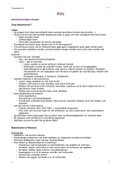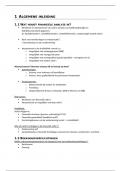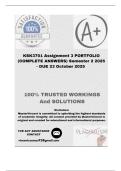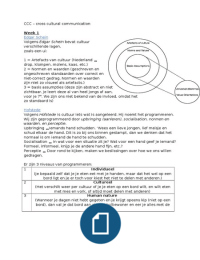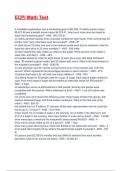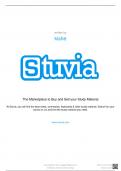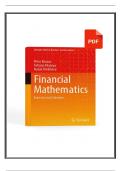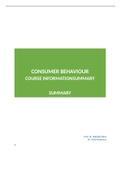0. Contents .......................................................................................................................................... 1
1. Introduction: The Need for Design Science in Software Architecture ............................................ 5
1.1. Wat is een software architect? ............................................................................................... 5
1.2. Concepts related to software architecture ............................................................................. 5
1.2.1. Science and engineering .................................................................................................. 5
1.2.2. On “Design Science” ........................................................................................................ 6
1.2.3. The Science of Design: time to build .............................................................................. 6
1.2.4. On Software Architecture................................................................................................ 6
1.3. Software architecture and need for traceability ..................................................................... 7
1.4. Nabespreking gastsprekers ..................................................................................................... 7
1.4.1. Pieter Dubois: XPLUS ....................................................................................................... 7
1.4.2. Peter Van Bellingen: Colruyt ........................................................................................... 8
1.5. Issues with IS Methodologies & Software Architecture .......................................................... 9
1.6. IS Methodologies ..................................................................................................................... 9
1.6.1. Scientific literature ........................................................................................................ 10
1.6.2. Which Methodologies ? ................................................................................................ 10
1.6.3. Authors of Methodologies ............................................................................................ 10
1.6.4. Advantages of Methodologies ...................................................................................... 10
1.6.5. Issue 1 – Adoption ......................................................................................................... 10
1.6.6. Issue 2 – Vagueness ....................................................................................................... 11
1.6.7. Issue 3 – Systematics ..................................................................................................... 11
1.6.8. Issue 4 - Traceability ...................................................................................................... 11
1.6.9. The Law of Increasing complexity: Manny Lehman ...................................................... 12
1.6.10. Crucial issues for software architecture ........................................................................ 12
2. NST Foundation Lecture 1: The Design Cycle as a Dynamic System ............................................. 12
2.1. Dynamic instability due to positive feedback ....................................................................... 13
2.2. From Stable Operations to Evolvable Designs ...................................................................... 13
2.3. Change Ripples: A Basic Transformation ............................................................................... 14
2.4. Ripple Effects in a Growing Modular Structure ..................................................................... 14
2.5. Design Theorems for Stable Software ................................................................................... 14
3. NST Foundation Lecture 2: Design Theorems for Software Stability ............................................ 15
3.1. Separation of Concerns – Reductio ad Absurdum ............................................................... 15
3.1.1. Solution: Separation of concerns .................................................................................. 15
3.1.2. Manifestations............................................................................................................... 16
3.1.3. Coding implications ....................................................................................................... 16
3.2. Action Version Transparency – Reductio ad Absurdum ........................................................ 16
3.2.1. The solution ................................................................................................................... 17
3.2.2. Manifestations............................................................................................................... 17
, 3.2.3. Coding implications ....................................................................................................... 17
3.2.4. Separate emerging concern .......................................................................................... 17
3.3. Data Version Transparency – reductio ad absurdum ............................................................ 18
3.3.1. Solution.......................................................................................................................... 18
3.3.2. Manifestations............................................................................................................... 18
3.3.3. Coding implications ....................................................................................................... 18
3.4. Separation of states............................................................................................................... 18
3.4.1. How to solve this? ........................................................................................................ 19
3.4.2. Manifestations............................................................................................................... 19
3.4.3. Coding implications ....................................................................................................... 19
3.4.4. Dangerous of synchronous object pipelines, thus use stateful workflow systems....... 19
3.4.5. Async Processing ........................................................................................................... 20
3.5. Design Theorems Interpreted ............................................................................................... 20
3.6. Coupling and Cohesion Revisited .......................................................................................... 20
3.7. Coupling and Cohesion Reinterpreted .................................................................................. 21
4. NST Foundation Lecture 3: Software Element Structures ............................................................ 21
1.1. Design theorems for stable software .................................................................................... 21
4.1. Encapsulating Basic Primitives .............................................................................................. 22
4.2. Separating Cross-cutting concerns ........................................................................................ 22
4.3. The emergence of Elements .................................................................................................. 23
4.4. An advanced Transformation ................................................................................................ 24
4.5. Instability of Basic Transformation ........................................................................................ 24
4.6. An Advanced Transformation................................................................................................ 24
4.7. Normalized Systems Elements .............................................................................................. 25
4.8. Expansion of Elements .......................................................................................................... 25
4.9. A Construction Concept Element .......................................................................................... 25
5. NST Foundation Lecture 4: Expansion, Harvesting, and Rejuvenation ........................................ 25
5.1. Recap ..................................................................................................................................... 26
5.2. On Updating Recurring Structure .......................................................................................... 27
5.2.1. Catch 22: The only way out ........................................................................................... 27
5.3. Expansion of Elements .......................................................................................................... 27
5.3.1. Expand Models to Codebase ......................................................................................... 28
5.3.2. Expand Templates to Codebase .................................................................................... 28
5.3.3. Third dimension: Connect Utilities to Codebase ........................................................... 28
5.3.4. A fourth dimension: Subjoin Craftings/custom code to Codebase ............................... 28
5.3.5. Re-generate and Inject Craftings ................................................................................... 29
5.3.6. Continuous Rejuvenation .............................................................................................. 29
5.4. Variability Dimensions and Expansion .................................................................................. 29
5.5. Deploying Elements in Layers ................................................................................................ 30
5.6. Packaging Elements in Archives ............................................................................................ 30
,6. NST Foundation Lecture 5: On Dimensions of Variability and Evolvability .................................. 31
6.1. Change Dimension 1: The Models/Mirrors ........................................................................... 32
6.1.1. Stable Changes 1: Mirrors – Data .................................................................................. 32
6.1.2. Stable Changes 1: Mirrors – Task .................................................................................. 32
6.1.3. Stable Changes 1: Mirrors – Flow .................................................................................. 33
6.2. Change Dimension 2: The Utilities ........................................................................................ 33
6.3. Change Dimension 3: The Skeletons ..................................................................................... 34
6.4. Change Dimension 4: The Craftings ...................................................................................... 34
7. NST Foundation Lecture 6: Realization of Meta-Circular Expansion............................................. 34
7.1. Automatic Programming ....................................................................................................... 34
7.2. The need for Automatic Programming.................................................................................. 35
7.3. The Field of Automatic Programming ................................................................................... 35
7.4. Relevance of Automatic Programming.................................................................................. 36
7.5. The Power of Circularity ........................................................................................................ 36
7.6. Meta-circularity in Software Engineering.............................................................................. 36
7.7. Why Meta-Circularity in Meta-Programming? ...................................................................... 37
7.7.1. Closing the Meta-Circle (phase 1) ................................................................................. 37
7.7.2. Closing the Meta-Circle (phase 2) ................................................................................. 37
7.7.3. Closing the Meta-Circle (phase 3) ................................................................................. 38
7.8. Need for Meta-Level Interfaces ............................................................................................ 39
7.9. Two-sided Meta-Level Interfaces .......................................................................................... 39
7.10. Closing the Meta-Circle: Expander API .............................................................................. 39
7.10.1. Expander API: Model/Mapping/Template .................................................................... 40
7.11. The Power of Circularity: Resonance ................................................................................ 40
8. NST Tutorial: From Element Structures to Implementation Classes ............................................. 40
8.1. The Emergence of Elements .................................................................................................. 41
8.2. An Advanced Transformation................................................................................................ 41
8.2.1. InvoiceDetails: Encapsulating Data Transfer ................................................................. 41
8.2.2. InvoiceData: Encapsulating JPA Code ............................................................................ 42
8.2.3. Multiple Concerns within a Concern ............................................................................. 42
8.2.4. Task entity: An Advanced Transformation .................................................................... 43
8.2.5. Deploying Elements across Multi-Tiers ......................................................................... 44
8.2.6. Packaging Element in Layered Archives ........................................................................ 44
9. Special topics: encapsulation of utility frameworks and integration layers ................................. 45
9.1. Encapsulating utilities through elements .............................................................................. 45
9.2. Deploying and Packaging Elements in Layers ........................................................................ 45
9.3. Data Element: Encapsulating Utilities ................................................................................... 45
9.4. Incoming integration ............................................................................................................. 46
9.5. Outgoing integration ............................................................................................................. 46
10. Chapter 16: IS Development and Analysis ................................................................................ 47
, 10.1. Recap: IS Methodologies ....................................................................................................... 47
10.2. Data Analysis Techniques ...................................................................................................... 47
10.2.1. EURent Data Model ....................................................................................................... 48
10.2.2. Flow Analysis Techniques .............................................................................................. 51
10.3. Integrated Analysis Models ................................................................................................... 53
10.4. The System Development Process ........................................................................................ 53
10.5. Reflections on Project Management ..................................................................................... 54
11. Gastcollege - Geert Haerens (ENGIE): Evolvable Software Architecture .................................. 54
11.1. Business logic Layer ............................................................................................................... 56
11.2. Use Cases ............................................................................................................................... 56
11.3. User interface – external technology .................................................................................... 56
11.4. User stories ............................................................................................................................ 56
11.5. Cross cutting concerns .......................................................................................................... 56
11.6. Agile & Architecture .............................................................................................................. 57
11.7. CONCLUSIE ............................................................................................................................ 58
12. Group assignment ..................................................................................................................... 59
12.1. Phase 1 Analysis: Issues ......................................................................................................... 59
12.2. Summary Metalessen ............................................................................................................ 59
12.3. Enkele andere niet-meta lessen ............................................................................................ 60
12.4. Examenvragen ....................................................................................................................... 61


